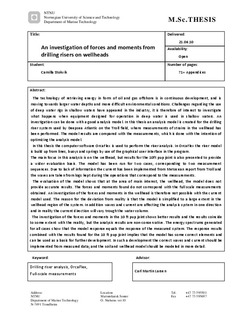| dc.contributor.author | Stokvik, Camilla | nb_NO |
| dc.date.accessioned | 2014-12-19T12:06:10Z | |
| dc.date.available | 2014-12-19T12:06:10Z | |
| dc.date.created | 2010-12-08 | nb_NO |
| dc.date.issued | 2010 | nb_NO |
| dc.identifier | 375505 | nb_NO |
| dc.identifier.uri | http://hdl.handle.net/11250/237829 | |
| dc.description.abstract | The technology of retrieving energy in form of oil and gas offshore is in continuous development, and is moving towards larger water depths and more difficult environmental conditions. Challenges regarding the use of deep water rigs in shallow waters have appeared in the industry, it is therefore of interest to investigate what happens when equipment designed for operation in deep water is used in shallow waters. An investigation can be done with a good analysis model. In this thesis an analysis model is created for the drilling riser system used by Deepsea Atlantic on the Troll field, where measurements of strains in the wellhead has been performed. The model results are compared with the measurements, which is done with the intention of optimizing the analysis model.
In this thesis the computer software OrcaFlex is used to perform the riser analysis. In OrcaFlex the riser model is build up from lines, buoys and springs by use of the graphical user interface in the program. The main focus in this analysis is on the wellhead, but results for the 10ft pup joint is also presented to provide a wider evaluation basis. The model has been run for two cases, corresponding to two measurement sequences. Due to lack of information the current has been implemented from Metocean report from Troll and the waves are taken from logs kept during the operations that correspond to the measurements.
The evaluation of the model shows that at the area of main interest, the wellhead, the model does not provide accurate results. The forces and moments found do not correspond with the full scale measurements obtained. An investigation of the forces and moments in the wellhead is therefore not possible with the current model used. The reason for the deviation from reality is that the model is simplified to a large extent in the wellhead region of the system. In addition waves and current are affecting the analysis system in one direction and in reality the current direction will vary trough the water column.
The investigation of the forces and moments in the 10 ft pup joint shows better results and the results coincide to some extent with the reality, but the analysis results are non-conservative. The energy spectrums generated for all cases show that the model response equals the response of the measured system. The response results combined with the results found for the 10 ft pup joint implies that the model has some correct elements and can be used as a basis for further development. In such a development the correct waves and current should be implemented from measured data; and the soil and wellhead model should be modeled in more detail. | nb_NO |
| dc.language | eng | nb_NO |
| dc.publisher | Norges teknisk-naturvitenskapelige universitet, Fakultet for ingeniørvitenskap og teknologi, Institutt for marin teknikk | nb_NO |
| dc.title | An investigation of forces and moments from drilling risers on wellheads | nb_NO |
| dc.type | Master thesis | nb_NO |
| dc.contributor.department | Norges teknisk-naturvitenskapelige universitet, Fakultet for ingeniørvitenskap og teknologi, Institutt for marin teknikk | nb_NO |
